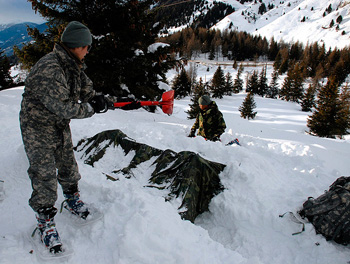Winter Survival Gear
Packing winter survival gear is not just about putting a load of ski jackets and thermal underwear into a bag and hoping for the best. You need to think about how you are going to feed yourself enough calories to keep off the cold, as well as being able to source water when a lot of the supply may be frozen. You will also need to prepare a survival gear list for your house and your car so that you are prepared, wherever you are, when "it" happens.
Generating Heat

Photo courtesy of The U.S. Army
While thick clothes will help to retain your body heat and keep covered body parts warm, you will need to have an external heat source ready for your exposed skin. Frostbite is a big risk during the winter months, and in the case of an apocalyptic event, medical help may never arrive. You will need a heat source that is self-sufficient and not dependent on the city gas supply, which makes a wood stove a great purchase.
Installing a wood stove in your house not only generates a lot of heat from a small amount of fuel but will also save you money now. Most modern wood stoves will burn just about any form of wood, and you can generally get the heat up high enough so that they'll burn green wood in an emergency. Ask your friends and family for any wooden items that they are getting rid of and store them somewhere dry.
Cooking
Part of any winter survival gear plan will need to think about food. Heating food without access to natural gas may be difficult, so you should try to get hold of a camping stove as a backup. However, learning how to make a survival stove out of materials you may have around your house will allow you to start cooking wherever you are, and will help generate a little bit of heat as well.
A survival stove will be an essential part of your winter survival gear, as it can be made out of anything that will contain heat, such as a tin can, a bucket or a metallic trash can. Punch holes in the side of the can to provide oxygen flow. You then place it on a heatproof surface and add one fluid ounce of alcohol fuel. Set fire to the fuel and completely cover it with your saucepan so that the stove becomes pressurized and the flames come out of the side. You get only eight minutes or so of heat from one fluid ounce, so you'll need meals that can be cooked in short spaces of time.
Clothing
The final part of your essential winter survival gear should be weather-appropriate clothing. Even if you plan to surf the apocalypse inside a building, you should consider packing outdoor survival gear in case the building has no heat and the winter weather becomes severe. This will include:
- Ski jackets
- Woolen socks
- Long thermal underwear
- Snow boots
- Gloves
The temptation will be to get hold of thick ski gloves, but these offer you limited mobility and dexterity. While the thicker gloves will keep your hands warmer, thinner gloves will let you get done whatever job needs doing in less time, meaning that you spend less time in the cold.
Your winter survival gear should also contain a survival blanket, also known as a space blanket. These foil sheets are handed out to survivors of accidents and are designed to retain almost 100% body heat. You may need to use these only in an emergency, but they are completely reusable. They should be part of your outdoor survival kit, so that you can hunker down anywhere.
Return from Winter Survival Gear to Survival Equipment





New! Comments
Have your say about what you just read! Leave me a comment in the box below.